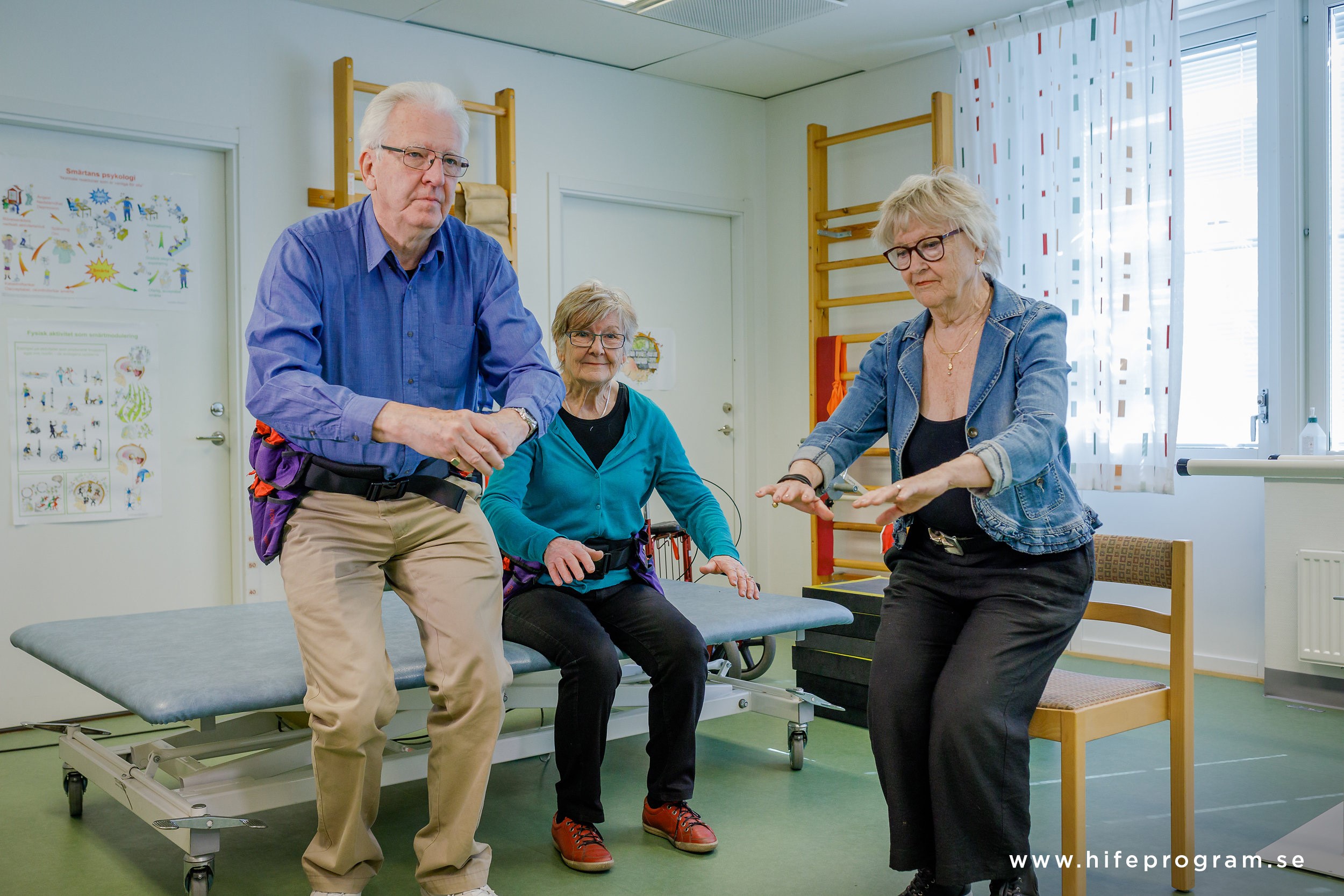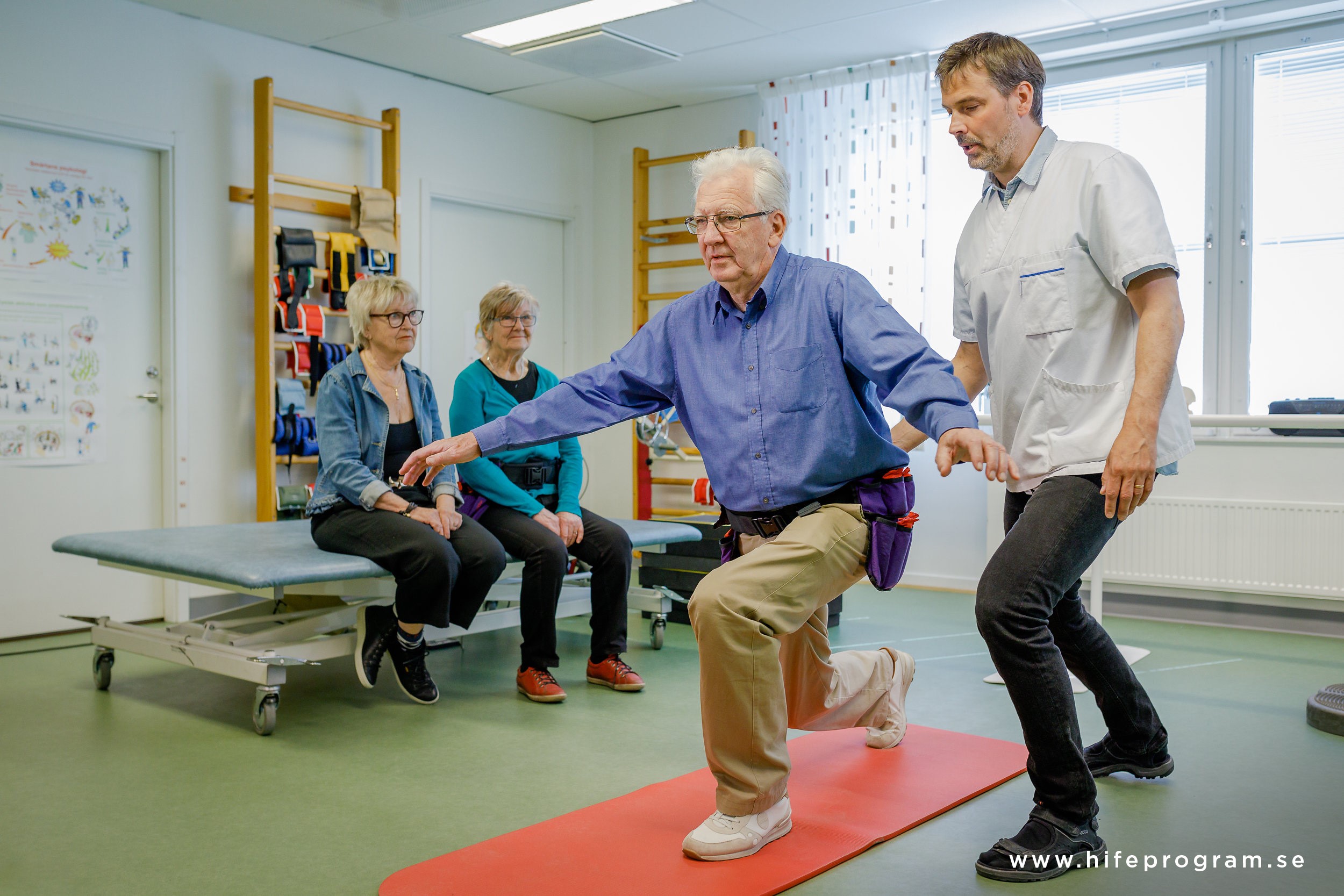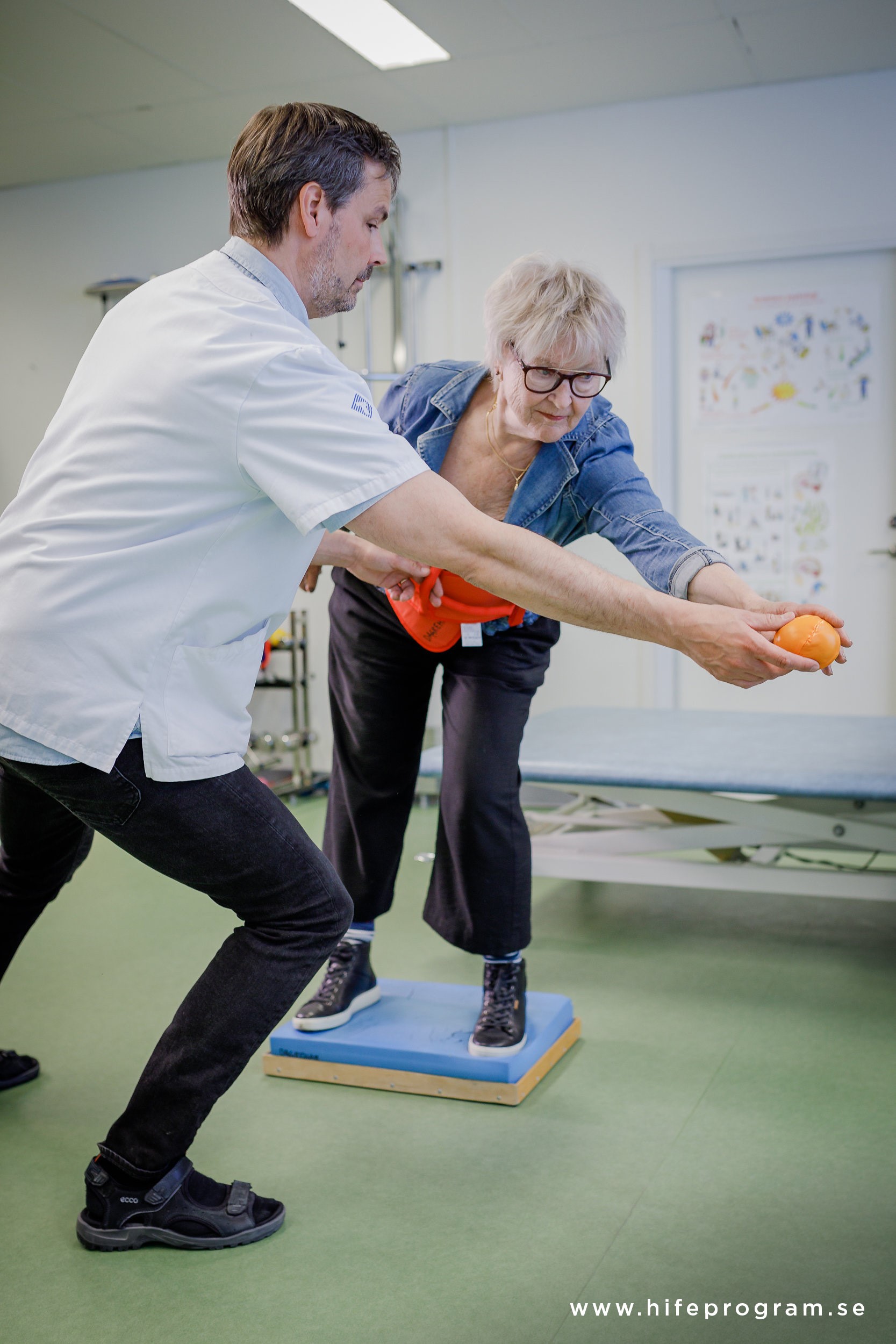Background
The High-Intensity Functional Exercise Program (the HIFE Program) was developed by the physical therapists Håkan Littbrand, Erik Rosendahl and Nina Lindelöf, 2001–2002 for the Frail Older People – Activity and Nutrition Study in Umeå (the FOPANU Study) at Umeå University, Sweden. The program was revised for the Umeå Dementia and Exercise Study (UMDEX) 2011.

Objective
The objective of the HIFE Program is to improve the participant’s lower-limb strength, balance, and mobility.
Criteria for the exercises:
-
Carried out in functional weight-bearing positions.
-
Applicable without access to special exercise facilities.
-
Adaptable for older persons with different functional capacity, including independent walkers and those needing help with all mobility.
-
Possibility to exercise progressively, either by increasing the difficulty in a specific exercise or by changing to another, more challenging, exercise.
39 exercises are included in the collection of exercises, distributed over five categories:
-
A - Static and dynamic balance exercises in combination with lower-limb strength exercises
-
B - Dynamic balance exercises in walking
-
C - Static and dynamic balance exercises in standing
-
D - Lower-limb strength exercises with continuous balance support
-
E - Walking with continuous balance support
Static balance exercises: Fixed base of support
Dynamic balance exercises: Changing base of support
The rationale for high-intensity functional exercise
The HIFE Program is based on current knowledge regarding exercise intensity and specificity. It comprises of functional exercises performed in weight-bearing positions and the participants are encouraged to exercise progressively at high intensity.

Exercise intensity
Intensity as a concept is described in various ways in the literature concerning exercise. In the HIFE Program, the intensity of the exercise is related to individual capacity, and the overall definition of high-intensity exercise is that the training is performed close to an individual’s maximum capacity.
Strength exercise
Based on the above overall definition, the intensity of strength exercise can be defined as high regardless of whether or not the particular weights used are heavy, or whether weights are used at all, as long as the exercises are performed close to the individual’s maximum capacity. The intensity of the strength exercises can have a major impact on the results. A greater effect on muscle strength has been reported after high intensity strength exercise than after low to moderate intensity exercise among older people.1-3 To ensure that a strength exercise program is performed at high intensity during an exercise period it needs to be progressive. Progressive strength exercise programs have been shown to improve muscle strength,1,4-6 and have positive effects on gait speed1,7,8 and dependence in activities of daily living (ADLs) in older people.1 In addition, progressive strength exercise may have a positive influence on aerobic capacity.1,9
The intensity of strength exercise can be described either as the absolute maximum number of times a weight is lifted, alternatively the maximum number of times a movement can be performed, or as the percentage of the maximum load lifted. The term RM (repetition maximum), introduced by DeLorme in 1945, is used in the literature to describe intensity in strength exercises. 1 RM is defined as the maximum load that can be lifted once and not more and, subsequently, 10 RM is the load that can be lifted ten times but not eleven.10 The intensity of muscle strengthening in the HIFE Program is defined in relation to RM, i.e. the maximum number of times a strength exercise can be performed with maintained technique.11 Observation of the number of maximum repetitions during the strength exercises allows the load to be adjusted during the training session.12 The participant is encouraged to exercise at high intensity, i.e. sets of 8-12 RM. Exercises are then progressed when participants are able to exceed 12 repetitions. The load in the functional exercises can be increased by, for example, stepping higher or adding weights to a belt worn around the waist. In the HIFE Program medium intensity is defined as sets of 13-15 RM and low intensity as sets of more than 15 RM.
The recommended intensity for older people when performing strength exercise is to use loads of 60-80% of 1 RM, which is assumed to correspond to 8-12 RM.13 For novice individuals, it is suggested that moderate loading (50-60% of 1 RM or less) should be used initially as it is important to learn a proper technique and to avoid injury.13 The assumption that 60-80% of 1 RM corresponds to 8-12 RM is widespread in the literature, but often without reference to any validation study.14-16 Few studies have evaluated the relationship between the percentages of 1 RM and the maximum number of repetitions during strength exercises.14-16 In a study by Hoeger et al. the maximum number of repetitions that could be performed at 40, 60, and 80% of 1 RM was investigated among healthy younger people.14 The study shows that the number of repetitions that could be performed at a selected percentage of 1 RM varied widely among the participants and among different types of lifts. Thus, the assumption that 60-80% of 1 RM corresponds to 8-12 RM is unconfirmed. For example, among young trained women, 60% of 1 RM in a leg press corresponded on average to 57 maximum number of repetitions and 80% of 1 RM corresponded to 22 maximum number of repetitions. The corresponding figures for leg curl (to 90 degrees of flexion) were 12 and 5 maximum number of repetitions, respectively. Consequently, describing the absolute maximum number of times a movement can be performed seems to be a more valid way of describing the exercise intensity, compared to using a percentage of 1 RM among younger people. It seems possible to generalize this interpretation to older people since there is nothing which indicates that there would be less variation in repetitions at a selected percent of 1 RM in this group.
Balance exercise
To achieve optimal effects on balance ability and prevention of falls in connection with balance exercises, it is recommended that postural stability be challenged and the difficulty progressively increased, as the participant improves their capacity.3,17-19 A systematic review reports that a greater relative effect was seen on fall prevention in programs which included exercises that challenged postural stability.19 The American College of Sports Medicine (ACSM) recommends that when performing balance exercises, the activities should include the following: (1) progressively difficult postures that gradually reduce the base of support; (2) dynamic movements that perturb the center of gravity; (3) stressing postural muscle groups; and (4) reducing sensory input from e.g. vision.3 To ensure that the balance program remains challenging it needs to be progressive. It is also essential that the balance exercises can be performed safely. Thus, challenging balance exercises often need close supervision. It is important, however, that the participant is not given unnecessary balance support, but tries to control the center of gravity on his/her own. According to the overall definition, the specific definition of balance exercise at high intensity in the HIFE Program is that postural stability is fully challenged, i.e. the balance exercises are performed near the limits of maintaining postural stability. Medium intensity is defined as postural stability not being fully challenged or fully challenged in only a minority of the exercises, and low intensity is defined as postural stability being challenged in no way.

Exercise specificity
In addition to its intensity, the type of exercise can also have a major impact on the results. Studies comparing the effects of different types of training regimes in various contexts, for example rehabilitation after hip fracture, indicate the importance of the exercises being task-specific, including both posture and movement pattern, if functional ability is to be optimally improved.13,20-27 In strength training programs, individual muscles are often exercised in isolation without reference to the context in which that muscle is required to function. However, as early as 1957, Rasch et al. showed that it is important to select exercises in which the posture is similar to that of the movements they are attempting to facilitate.28 It was shown that the increases in elbow flexor strength after a period of strength exercise were considerably larger when the subjects were tested in the position in which they had practiced (standing) than when the elbow flexor muscles were tested with the body in another position (supine). Consequently, strength training for isolated muscle groups in a position that is not similar to the position at which the improvement is aimed seems not to be the most effective way of increasing the performance of a specific task. It would seem better to incorporate the strength exercises into those tasks which are the object of improvement, where the subject learns how to optimally coordinate the various muscle groups involved in the movements.
Functional weight-bearing exercises, such as rising from a chair or step-ups, follow the principle of exercise specificity, since they mimic movements used in everyday tasks and, thus, represent a promising method for achieving optimal effects on functionality in daily activities. Subsequently, it seems suitable to offer older people, including people with cognitive impairment, functional weight-bearing exercise, which is what the HIFE Program is based on. People with dementia have the capacity to improve their motor skills, but it seems particularly important that the exercises are task specific because of the concomitant difficulty with motor skill transfer i.e. the ability to use acquired skills in new contexts.29-31 Furthermore, mobility problems, e.g. difficulties in getting out of a chair, walking in various directions or climbing stairs, are often related to a combination of impairments in static and dynamic postural control and lower-limb strength. It is therefore important to design an exercise program aimed at improving these functions. The functional exercises included in the HIFE Program allow for the possibility of designing such exercise programs.
References
- Liu CJ, Latham NK. Progressive resistance strength training for improving physical function in older adults. Cochrane Database Syst Rev. 2009;(3):CD002759.
- Raymond MJ, Bramley-Tzerefos RE, Jeffs KJ, et al. Systematic review of high-intensity progressive resistance strength training of the lower limb compared with other intensities of strength training in older adults. Arch Phys Med Rehabil. 2013;94:1458-1472.
- American College of Sports M, Chodzko-Zajko WJ, Proctor DN, et al. American College of Sports Medicine position stand. Exercise and physical activity for older adults. Med Sci Sports Exerc. 2009;41:1510-1530.
- Paterson DH, Warburton DE. Physical activity and functional limitations in older adults: a systematic review related to Canada's Physical Activity Guidelines. Int J Behav Nutr Phys Act. 2010;7:38.
- Peterson MD, Rhea MR, Sen A, et al. Resistance exercise for muscular strength in older adults: a meta-analysis. Ageing Res Rev. 2010;9:226-237.
- Borde R, Hortobagyi T, Granacher U. Dose-Response Relationships of Resistance Training in Healthy Old Adults: A Systematic Review and Meta-Analysis. Sports Med. 2015;45:1693-1720.
- Van Abbema R, De Greef M, Craje C, et al. What type, or combination of exercise can improve preferred gait speed in older adults? A meta-analysis. BMC Geriatr. 2015;15:72.
- Hortobagyi T, Lesinski M, Gabler M, et al. Effects of Three Types of Exercise Interventions on Healthy Old Adults' Gait Speed: A Systematic Review and Meta-Analysis (vol 45, pg 1627, 2015). Sports Medicine. 2016;46:453-453.
- Giuliano C, Karahalios A, Neil C, et al. The effects of resistance training on muscle strength, quality of life and aerobic capacity in patients with chronic heart failure - A meta-analysis. Int J Cardiol. 2017;227:413-423.
- DeLorme TL. Restoration of muscle power by heavy-resistance exercises. J Bone and Joint Surg. 1945;27:645-667.
- Pollock ML, Gaesser GA, Butcher JD, Després J-P, Dishman RK, Franklin BA, Garber CE, American College of Sports Medicine Position Stand. The recommended quantity and quality of exercise for developing and maintaining cardiorespiratory and muscular fitness, and flexibility in healthy adults. Med Sci Sports Exerc. 1998;30:975-991.
- American College of Sports Medicine Guidelines for Exercise Testing and Prescription, 8th Ed., 2010, page 90.
- American College of Sports Medicine. American College of Sports Medicine position stand. Progression models in resistance training for healthy adults. Med Sci Sports Exerc. 2009;41:687-708.
- Hoeger WWK, Hopkins DR, Barette SL, et al. Relationship between repetitions and selected percentages of one repetition maximum: a comparison between untrained and trained males and females. Journal of Applied Sport Science Research. 1990;4:47-54.
- Richens B, Cleather DJ. The relationship between the number of repetitions performed at given intensities is different in endurance and strength trained athletes. Biol Sport. 2014;31:157-61.
- Shimano T, Kraemer WJ, Spiering B, et al. Relationship between the number of repetitions and selected percentages of one repetition maximum in free weight exercises in trained and untrained men. J Strength Cond Res. 2006;20:819-823.
- Fiatarone Singh MA. Exercise comes of age: rationale and recommendations for a geriatric exercise prescription. J Gerontol Series A Biol Sci Med Sci. 2002;57:M262–M282.
- Lord S, Sherrington C, Menz H et al. Falls in Older People: Risk Factors and Strategies for Prevention, 2nd Ed. Cambridge, United Kingdom: Cambridge University Press, 2007.
- Sherrington C, Michaleff ZA, Fairhall N, et al. Exercise to prevent falls in older adults: an updated systematic review and meta-analysis. Br J Sports Med. 2017;51:1750-1758.
- Augustsson J, Esko A, Thomeé R et al. Weight training of the thigh muscles using closed vs. open kinetic chain exercises: a comparison of performance enhancement. J Orthop Sports Phys Ther. 1998;27:3-8.
- Dean CM, Shepherd RB. Task-related training improves performance of seated reaching tasks after stroke. A randomized controlled trial. Stroke. 1997;28:722-728.
- de Vreede PL, Samson MM, van Meeteren NL et al. Functional-task exercise versus resistance strength exercise to improve daily function in older women: a randomized, controlled trial. J Am Geriatr Soc. 2005;53:2-10.
- Krebs DE, Scarborough DM, McGibbon CA. Functional vs. strength training in disabled elderly outpatients. Am J Phys Med Rehabil. 2007;86:93-103.
- Olivetti L, Schurr K, Sherrington C et al. A novel weight-bearing strengthening program during rehabilitation of older people is feasible and improves standing up more than a non-weight-bearing strengthening program: a randomised trial. Aust J Physiother. 2007;53:147-153.
- Rutherford OM. Muscular coordination and strength training. Implications for injury rehabilitation. Sports Med. 1988;5:196-202.
- Sherrington C, Lord SR, Herbert RD. A randomized controlled trial of weight-bearing versus non-weight-bearing exercise for improving physical ability after usual care for hip fracture. Arch Phys Med Rehabil. 2004;85:710-716.
- Wilson GJ, Murphy AJ, Walshe A. The specificity of strength training: the effect of posture. Eur J Appl Physiol Occup Physiol. 1996;73:346-352.
- Rasch PJ, Morehouse LE. Effect of static and dynamic exercises on muscular strength and hypertrophy. J Appl Physiol. 1957;2:29-34.
- Dick MB, Hsieh S, Bricker J, et al. Facilitating acquisition and transfer of a continuous motor task in healthy older adults and patients with Alzheimer's disease. Neuropsychology. 2003;17:202-212.
- Dick MB, Hsieh S, Dick-Muehlke C, et al. The variability of practice hypothesis in motor learning: does it apply to Alzheimer's disease? Brain Cogn. 2000;44:470-489.
- van Halteren-van Tilborg IA, Scherder EJ, Hulstijn W. Motor-skill learning in Alzheimer's disease: a review with an eye to the clinical practice. Neuropsychol Rev. 2007;17:203-212.